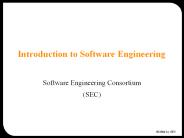Art for Chapter 12, Software Life Cycle - PowerPoint PPT Presentation
1 / 18
Title:
Art for Chapter 12, Software Life Cycle
Description:
Art for Chapter 12, Software Life Cycle Figure 12-1. Simple life cycle for software development (UML use case diagram). Figure 12-2. Simple life cycle for software ... – PowerPoint PPT presentation
Number of Views:107
Avg rating:3.0/5.0
Title: Art for Chapter 12, Software Life Cycle
1
Art forChapter 12,Software Life Cycle
2
Figure 12-1. Simple life cycle for software
development (UML use case diagram).
3
Figure 12-2. Simple life cycle for software
development (UML activity diagram).
4
Figure 12-3. Another simple life cycle (UML
activity diagram).
5
Figure 12-4. Entity-centered view of software
development (UML class diagram).
6
Figure 12-5. Activities and products of the
simple life cycle of Figure 12-2 (UML class
diagram).
7
Figure 12-6. Model of the software life cycle
(UML class diagram). A software life cycle
consists of process groups, which in turn consist
of processes. A process accomplishes a specific
purpose (e.g., requirements, design,
installation). A process consists of activities,
which are in turn consists of sub-activities or
tasks. Tasks represent the smallest piece of work
that is relevant to management. Tasks consume
resources and produces one or more work products.
A project is an instance of a software life cycle.
8
Figure 12-7. Process interrelationships in the
IEEE 1074 standard (UML activity diagram, adapted
from IEEE Std. 1074-1995. As suggested by this
picture, dependencies among processes and
activities are complex and seldom allow a
sequential execution of processes.
9
Figure 12-8. The waterfall model of software
development is an activity-centered view of the
software life cycle Software development
activities are performed in sequence (UML
activity diagram adapted from Royse, 1970 using
IEEE 1074 names project management and
cross-development processes are omitted).
10
Figure 12-9. Waterfall model for the DOD Standard
2167A (UML activity diagram). Note activities
specific to the DOD are used instead of IEEE 1074
activities. Decision points denote reviews The
subsequent activity is initiated only if the
review is successful.
11
Figure 12-10. V-Model of software development.
12
Figure 12-11. Boehms spiral model (Adapted from
Boehm, 1987). The distance from the origin
represents the cost accumulated by the project.
The angle from the horizontal represents the type
of activity. For example, the project P1 is
currently in the risk analysis activity
associated with software requirements. The
project P2 is in the development of the system
product design.
13
Figure 12-12. Sawtooth Model with two prototype
demonstrations (UML activity diagram). The Client
swimlane encloses the activities that are visible
to the client, whereas the Developer swimlane
encloses the activities that are at a lower
abstraction level.
14
Figure 12-13. Shark tooth model with two
prototype demonstrations and 1 review (UML
activity diagram, levels of abstraction are
represented with swimlanes). Small teeth reaching
the management swimlane are internal reviews
involving a prototype demo by the developers for
the project manager. Large teeth reaching the
client swimlane are prototype demonstrations to
the client.
15
Figure 12-14. Entity-centered life cycle view of
the models of the Unified Process (UML class
diagram). the dependencies depict traceability.
There are dependencies between all models. Only
the dependencies between the use case model and
the other models are shown Jacobson et al.,
1999.
16
Figure 12-15. Snapshot of a project issue base
(UML object diagram). Issues i1 and i5 have been
resolved, whereas all other issues are still
open. Dependencies among issues indicate that the
resolution of an issue can constraint the
alternatives for dependent issues.
17
Figure 12-16. The waterfall model as a special
case of the issue-based life cycle model (UML
object diagram). All issues that belong to the
same issue category are contained in the same UML
package. In the project status shown in the
figure, all the requirements elicitation and
analysis issues have been closed that is, the
requirements elicitation and analysis activities
have been completed.
18
Figure 12-17. In a complex project state, all
activities can still have some open issues, which
means that all activities need to be managed
concurrently.































